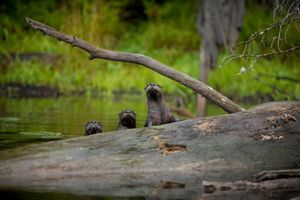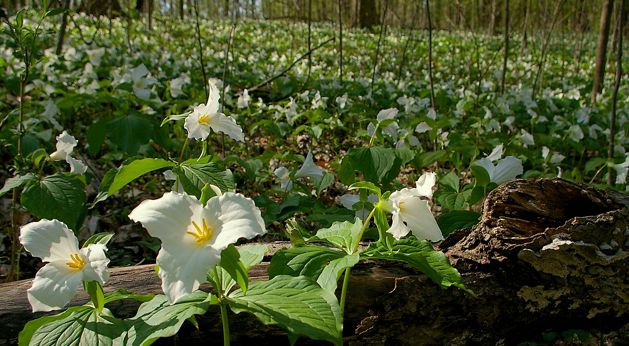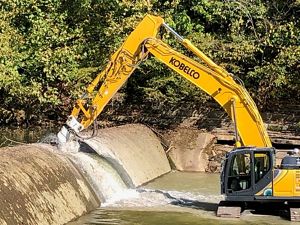The Wabash River has served as a vital conduit for trade, travel and settlement in the Midwest for more than two centuries. It is inextricably linked to Indiana’s economy and well-being. Apart from its historic significance, the Wabash is also a treasure chest of rare and endangered species, and serves as the habitat for a wide diversity of plant and animal life.
Dead Zone: Reducing Nutrient Pollution
Researchers have pinpointed Indiana’s rivers as disproportionately high contributors of fertilizers, or nutrients, in the pollution of the Mississippi River Watershed. These nutrients have caused a Dead Zone in the Gulf of America, where no marine life can survive due to the lack of oxygen.
The Wabash River, despite only covering 3% of the Mississippi River Basin, contributes 1-7% of the flow of water and sends a disproportionate 11-17% of nutrients.
In addition to farming, urban pollutants from lawns, construction sites, industrial sites and roads exacerbate the problem. Fortunately, these trends can be reversed through a variety of practices, including responsible use of fertilizer. The Nature Conservancy is working with partners to achieve a 20% reduction in nutrients entering the Mississippi River Basin.
The Lower Wabash River
Forests and wetlands along the Wabash River harbor many native species, including osprey, bald eagles, bobcats, river otters and the Indiana bat.






Least bittern: Least bittern © Elie Tabet

Bobcat: Bobcat along the lower Wabash River in southwestern Indiana. © Ron Harper

River otters: Successful reintroduction efforts are slowly restoring otter populations in many states. © Aaron Peterson

Hovey Lake: Sunset at Hovey Lake Fish and Wildlife Area in southwestern Indiana © Ron Harper

Pelicans: Pelicans at Hovey Lake Fish and Wildlife Area in southwestern Indiana © Ron Harper
FACTS ABOUT THE WABASH RIVER
- The Wabash River is more than 500 miles long and spans the entire state of Indiana. It contains the longest stretch (411 miles) of free-flowing river east of the Mississippi River, with the Roush Dam in Huntington as the division.
- The Wabash and its connected rivers and streams provide drinking water to 72% of Indiana counties.
- The river is home to 120 endangered, threatened or rare plants and animals.
- In addition to these species, the river is home to 150 species of fish, including largemouth bass, smallmouth bass, sauger, rock bass, catfish and paddlefish—the oldest surviving animal species in North America.
- Forests and wetlands along the Wabash River harbor many native species, including osprey, bald eagles, bobcats, river otters and the Indiana bat.
ISSUES IN THE WABASH RIVER
- 7 fish species and 18 mussel species that were once native to the river are no longer found there.
- Decades of draining and developing land in the Wabash River watershed has degraded the quality of its waters.
- Loss of wetlands and natural riparian areas, coupled with increased run-off rates have contributed to more intense flooding and riverbank erosion.
- Sediments and pollutants from agricultural fields and urban areas have contributed to the Gulf of America’s hypoxic zone, and has severely affected the Gulf’s fisheries and wildlife. The Gulf of America hypoxic zone was first documented in 1972 and is one of the largest of the 400 hypoxic zones around the globe.
What TNC is Doing
Through partnerships and community-outreach, we are constantly working to conserve and protect the Wabash River and its surrounding lands. The Nature Conservancy continues to collaborate with private landowners, state and federal agencies and farmers to ensure that Indiana’s state river remains a healthy habitat for the life it supports and the communities that depend on it.
Collaborations include:
- Farmers Leading Change – TNC is playing a leadership role in establishing effective and sustainable farmer peer groups across the state with key partners. Research and program exit surveys indicate that farmers trust insight from fellow farmers when committing to change.
- Farmer Advisors and Service Providers – TNC has developed strong relationships with farmer advisors like Certified Crop Consultants, Ag Retailers and other independent consultants to co-produce messaging and programming around best management practices that are effective with farmer and landowner audiences.
- Corporate Sustainability – Through intentional relationships with business, TNC is reaching another tier of conservation adopters. TNC provides expertise in implementing corporate sustainability efforts by transferring concepts and goals to action and outcomes.
- Innovation – TNC is constantly innovating creative solutions to balance a broad set of variables in improving environmental outcomes alongside human wellbeing. TNC also seeks out partners in all sectors who are addressing unsolved problems that require new and ambitious thinking.
- Public Policy and Programs – TNC is a well-trusted partner in executing government programs and grants across the Midwestern landscape for improvement of soil health, water quality, forestry, habitat improvement and equity. TNC also works to co-develop public policies that drive positive change related to wetlands, modern agriculture and other key topics.
The Wabash River Super Gage: Tiny but Mighty for Conservation in Indiana
Along the Wabash River near New Harmony sits the small super gage, silently collecting data which has already had big impacts to move water quality improvements in our state forward.
In 2018, with funding support from Nestle’ Purina Pet Care, Walton Family Foundation and Enterprise Rent a Car Foundation, The Nature Conservancy established a partnership with Indiana State Department of Agriculture (ISDA) and United States Geological Survey (USGS) to install a super gage at the base of the Wabash River in New Harmony.
The super gage, installed and managed by USGS, the preeminent Federal agency charged with monitoring water quality across the country, is continuously collecting water quality information from the river as it exits Indiana and pours into the Ohio River, to both clearly illustrate Indiana’s impact on our downstream neighbors and inform the scale of conservation needed to achieve our state water quality goals.
More Science on the Wabash River
TNC is partnering with Gybe Water Quality to use satellite imagery to monitor water quality at a never before seen scale. The GybeMaps sensors track changes in turbidity (clarity of the water), chlorophyll-a and more across the Wabash River basin.
Our Staff in Indiana
Meet Carrie Parmenter
Carrie Parmenter spent her childhood surrounded by farm fields in a small town in Southeast Illinois on the Wabash River. Growing up on the family farm, she learned the importance of stewardship by watching her father and grandfather practice conservation farming.
Her passion for the environment led her to pursue higher education at Truman State University in Kirksville, Missouri, where she earned a degree in Agriculture with an emphasis in Natural Resource Conservation. She spent over a decade working for local Soil and Water Conservation Districts in Southwest Indiana before joining The Nature Conservancy (TNC).
Carrie's wealth of experience laid the foundation for her transition to TNC’s watershed work. Her local connections and diverse skill set, ranging from implementing watershed plans to providing environmental education, have positioned her as a valuable asset in the organization's efforts to protect and restore the natural landscapes along the Wabash River in southwestern Indiana.
Carrie’s current role positions her at the forefront of a critical mission – restoring floodplains along the lower Wabash River. Recognizing the importance of these natural areas for biodiversity, water quality and flood control, she employs her agricultural knowledge to implement sustainable practices that benefit both the environment and local communities.
Carrie and her husband Ryan live in Mt. Vernon, Indiana where they raised their three sons. Her love for the outdoors extends beyond her work, as she enjoys spending time hiking, kayaking and gardening. Additionally, she enjoys exploring new places and serving on international mission trips.
Meet Seth Harden
Seth Harden grew up in rural community in central Indiana, where he developed a deep understanding of agriculture and the Midwestern landscape. With a seven-generation agrarian heritage in Indiana, he considers conservation of our state’s natural resources as imperative to that continued legacy.
Along with encouraging parents, formative experiences in scouting, 4-H, and FFA shaped a career path in natural resources. A Bachelor of Science in Forestry degree from Purdue University and Master of Public Affairs degree from the O’Neill School of Public and Environmental Affairs with a concentration in environmental policy analysis, Seth approaches his fieldwork with a strong science background. Prior roles and experiences at USDA and policy organizations add a degree of pragmatism to how Seth approaches solutions and partnership building in the Wabash River Basin.
After joining the Indiana Freshwater Conservation Team at TNC in 2016, Seth’s role has had a particular focus on discovering, testing, and implementing solutions that support conservation best management practice adoption on Indiana farms. This work is most often accomplished through social science and public-private partnership building. Stewarding collaboration and relationships are what Seth considers most important in achieving outcomes for water quality, biodiversity, and soil health in the upper Wabash River basin.
Seth and his wife Laura live in Westfield, Indiana with their four children. He enjoys camping, cast iron cooking, canoeing, and annual trips to Michigan with his family, where he is always looking for another river to explore. Seth also maintains close connections to his alma mater, Purdue University through alumni association leadership.
Additional Resources
-
USGS New Harmony Super Gage
The super gage, installed and managed by United States Geologic Survey, is continuously collecting water quality information from the river as it exits Indiana and pours into the Ohio River. View data from the New Harmony Super Gage
-

ISDA's Indiana Science Assessment
The Indiana State Deparment of Agriculture's Indiana Science Assessment was born out of the desire to improve the process of how nutrient load reductions are determined for best management practices. Learn more about the Science Assessment
-

Trends of Sediment and Nutrient Loads in Indiana Watersheds
The Indiana State Department of Agriculture released this report, which provides results from the Indiana State Science Assessment. Read the report.

Let Nature Take Root in Your Inbox
Get the latest news, photos and opportunities near you, delivered monthly. Get a preview of our Nature News email.






